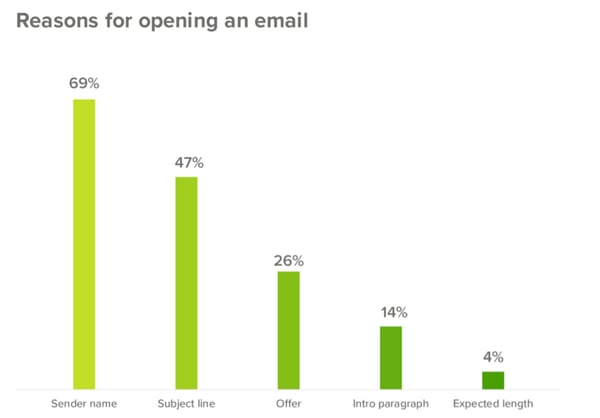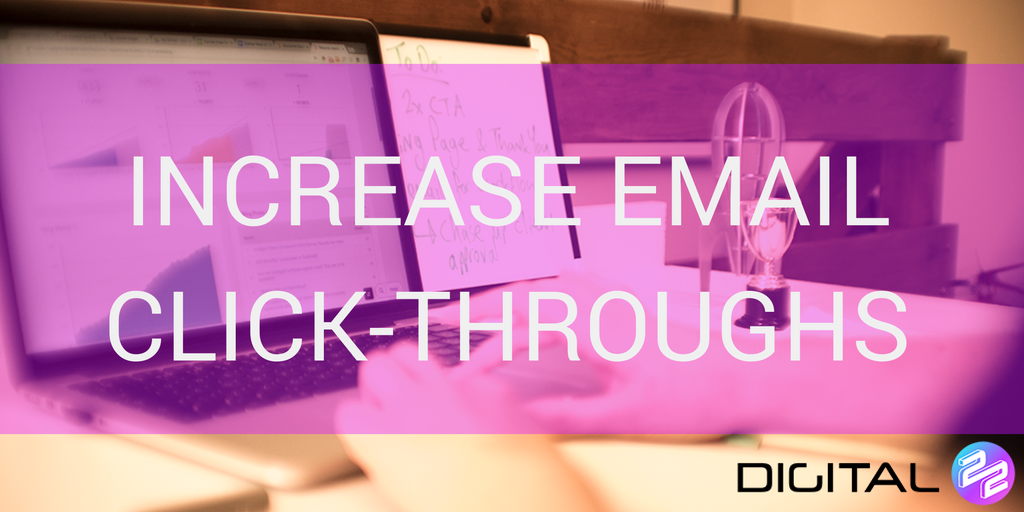Email marketing is a key part of any inbound marketing strategy. An engaging email is capable of...
Email marketing is a big part of our service offering here at Digital 22. It’s also one of the key marketing tools utilised within the inbound methodology.
There are many reasons for this. As well as being a powerful way to communicate with your audience at a personalised level, email marketing also provides businesses with the golden opportunity of reaching the right people at the right time.

However, it isn’t always that straightforward. Cluttered inboxes, delivery issues and changes in consumer habits can sometimes mean that the well-crafted emails your team puts together don’t always perform as well as you expect them to.
That’s where Seventh Sense comes into the equation.
In this blog, I’ll discuss the benefits we’ve seen from incorporating Seventh Sense into our clients’ email marketing strategies. Whether you’re looking to increase deliverability or simply want to take your email marketing up a notch, Seventh Sense can make all the difference.
Are you looking for new ways to break through the clutter and let your beautiful emails get the attention they truly deserve? Grab yourself a coffee (and a tasty assortment of biscuits) and find out more about how you can improve your email marketing strategy using intelligent software.
- What is email marketing?
- What are the different types of email marketing?
- What should you consider when it comes to approaching your email marketing strategy?
- What is Seventh Sense?
- What are the benefits of using Seventh Sense?
What is email marketing?
Before we get into the nitty-gritty, let’s go back to basics. HubSpot defines email marketing as “the process of targeting your audience and customers through email. It’s utilised to help you boost conversions and revenue by providing customers with valuable information to achieve their goals.”
This form of marketing has been around for a long time. Over 40 years to be precise. In 1978, a Marketing Manager called Gary Thuerk used this method of communication to tell people about a new product.
The results were monumental and marketing changed forever. Since then, email has become a crucial part of most brands' marketing strategies due to its strong return on investment and the ability to support business growth.
What are the different types of email marketing?
There are different types of email marketing businesses can utilise. Some may use email to promote their products and others may use email for educational purposes. However, if you want to get the most from email marketing, you should include different types within your campaigns.
Here’s a breakdown of some of the most popular types of email marketing you need to send:
1. Newsletters
B2C audiences love newsletters. They provide interesting updates and there’s an opportunity for businesses to build high levels of trust through the use of personalised content.
This personalised approach is one of the most effective tactics used in email marketing. Studies have found that 84% of consumers say being treated like a person and not a number is very important to winning their business.
Newsletters are also extremely prominent in the B2B industry. This is because they allow businesses to showcase their products and services and also regularly update their audience on any industry trends or important information on a large scale.
2. Lead nurturing emails
Depending on the specific action one of your persona takes, you may decide to enrol them into a lead nurturing campaign.
Research has found these types of emails receive 4-10 times the response rate compared to standalone email blasts. If you aren’t using lead nurturing within your email strategy already, it’s something to consider.
Response rates are so high with these types of emails for a number of reasons. As well as allowing you to establish contact immediately, lead nurturing emails are an effective way to learn more about your leads and, in turn, build meaningful relationships.
3. Promotional emails
Everyone loves a good deal and promotional emails are the perfect place to entice your customers into making a purchase.
They also tend to have more impact than other types of promotions. This is because they’re sent to an engaged list of people who are expecting to receive your communications.
Yes, promotional emails are old school. Yes, they’re also probably the most popular type used by businesses. There’s a reason for this. They’re extremely effective and are a great way of driving sales at a considerably low cost in comparison to other methods of marketing.
4. Welcome emails
First impressions last, so always make sure you spend some time crafting an exciting welcome email which people will receive once they sign up to your mailing list.
This first email you send to people presents a fantastic opportunity to build credibility, enhance your brand and also take the initial step into building meaningful relationships.
These are just a few of the most popular types of email marketing available. There are loads more out there. However, before you start sending out loads of different types of emails to your contacts, you need to consider a few different areas during the strategy phase.
What should you consider when it comes to approaching your email marketing strategy?
Like most areas of marketing, the strategy phase of sending emails has a significant role to play. There’s quite a lot to consider, so here’s a breakdown of some of the key aspects to focus on when it comes to approaching your email marketing strategy:
Segmenting your database
List segmentation is one of the best practices when it comes to email marketing. Most businesses won’t be able to cater to just one type of customer. People have different motivations to buy products and services.
This means it's really important to break your email database into various segments and tailor content to those individual buckets of contacts. Not only will this improve your email reputation but you’ll also naturally start to achieve better results. Bingo.
Using personalisation in your emails
Econsultancy found that only 5% of companies personalise extensively. When you consider the fact that 80% of people who receive personalised emails from vendors would be likely to purchase from them again, these figures are drastically low.
Personalisation isn’t just greeting someone by their first name in your email subject line. It comes in many different forms. Platforms such as HubSpot allow you to personalise information such as company names, job titles and locations.
This is one of the most important areas to consider when it comes to email strategy. Personalisation has many benefits for businesses, some of which include improved engagement and better quality lead generation.
Send mobile-friendly emails
Each time you send an email, you should always be aware that a portion of your subscribers will open it on their phones or tablets. Having a mobile-friendly design is no longer just nice to have, it’s a must-have.
Creating a responsive email template is a key part of any email marketing strategy. Responsive email design is an excellent way to make sure all of your customers receive the information they need in a user-friendly format.
Here’s an article from HubSpot which discusses some interesting tips which will help when it comes to optimising your email for mobile devices.
Sending emails at the right time
Like I’ve already said, people are different. They have different routines, work in different job roles and most importantly, open their emails at completely different times (he sighs).
This makes it tricky to establish ‘the perfect time to send an email’ to your audience. The task of capturing someone's attention as they scroll through their inbox becomes increasingly difficult.
Time has to be spent analysing data. Assumptions have to be made. You and your team have to laboriously test out different emails at different times to ultimately hit the jackpot and discover the golden hour.
Well, not any longer.
Now is the time we get stuck into the interesting stuff. Here’s where I introduce you to the magnificent creation known as Seventh Sense.
What is Seventh Sense?
In a nutshell, Seventh Sense is AI software designed to personalise email delivery times and frequency for maximum performance and engagement.
By delivering emails individually, at the time they’re most likely to be opened and read by each contact, you’ll begin to reap many different benefits.
Some of these include re-engaging dormant leads, increasing opens and clicks and also driving higher numbers of conversions over time.
We joined forces with Seventh Sense here at Digital 22 around a year ago. I was lucky enough to take the lead on the project and since then, I’ve built a really great relationship with their Founder and CEO, Mike.
I’ve also helped the Digital 22 team roll out Seventh Sense for all of our clients. It’s become an integral part of our email marketing strategy here and some of the results it’s produced have been absolutely fantastic.
A little humble-brag, but as I was researching data for this post, I reached out to Mike to get his thoughts on the nearly year long partnership. Here was Mike’s response:
“A lot of agencies, and marketers for that matter, are looking for silver bullets, but these simply do not exist in the world of marketing. There’s never 'one thing or tactic' you can do that will change the entire trajectory of your business. Instead it’s an integrated strategy that comes with experimentation that will define your success.
"This is where Digital22 sets themselves apart. They know this and are willing to put in the hard work and optimise where they’re seeing success. Email happened to be one of those areas. When we first started working with the team, we quickly saw how strong the email programs that Digital22 had built for themselves and their clients and knew we could have an impact in making these programs even more successful.
"At the outset of the relationship, the team put us through the ringer, but that’s what has made the partnership (and results) that much stronger. In short, Digital22 has been one of our most valued partnerships in our company history!”
So, without further ado, here are some examples of how integrating an AI platform like Seventh Sense can help your business take your email marketing up a notch.
What are the benefits of using Seventh Sense?
Increasing audience activity
In an ideal world, every contact on your email list would be active and highly engaged with your content. Unfortunately, for most companies, that’s not how the real picture tends to look.
This leaves many marketers in a catch-22 situation. The most sensible option would usually be to create a list which archives inactive subscribers and stop sending them emails moving forward.
Why? Sending emails to inactive customers will eventually begin to hurt your email send score.
If an email network such as Google starts to see that you’re consistently sending emails to people who aren’t opening them, there’s a good chance they’ll start diverting your emails to the spam folder.
According to Mike:
“Email domain reputation/deliverability is typically an afterthought with most marketers, however, it can be one of the most impactful components of a successful email program. One of the reasons this is so widely misunderstood is that marketers believe that a 99.8% successful delivery metric means you made it to the inbox. Whereas, all this really means is that 99.8% of your email didn't bounce.
"A good metaphor is similar to the way physical mail flows through the postal system. Your mail might have made it to the post office (email delivery with Google / Microsoft / Corporate Email Systems), but that doesn't mean it made it to the physical mailbox of your recipient (inboxing). Let alone make it to the hands of the actual recipient (inbox impression with the opportunity to be opened, read and acted upon).”
However, whether the archive strategy is the right one is open for debate. Some would say an inactive subscriber is better than a non-existent one.
When you consider that acquiring a new customer can cost five times more than retaining an existing one, it’s fair to say that creating an archive list and completely ignoring them is the wrong way to go about doing your business.
Instead, look for the positives. At some point in time, an inactive subscriber was interested in your brand in one way or another. You should, therefore, be looking for ways to encourage them to rejoin your active list.
One example of a strategy both Digital 22 and Seventh Sense have seen work is to reduce the frequency or number of emails you’re sending to your passive and/or inactive subscribers.
Sometimes people just need a break and by giving them some breathing room, you can naturally re-engage them. If you’re having a physical conversation, you can tell by the body language of someone whether their interest is waning. If so, you don’t continue talking. You change the subject, move on or ask if you can take it up at another time.
In the world of email marketing, people are leaving digital language behind in the form of opening, reading and engaging with your emails. Use this to your advantage much like you would with a physical conversation.
Here’s how intelligent software can make the difference
Analysis is unquestionably more important than anything else when it comes to email marketing. If you don’t keep a close eye on the numbers, you’ll never know what’s working and what isn’t.
With this in mind, I poured myself a strong cup of coffee a few weeks ago and started collating some metrics for each of our clients.
My first port of call was to measure all of our clients’ active audience percentage from when we started using Seventh Sense. I then compared how much this number had increased to date since we’ve been proactively using the platform.
The findings made my eyes water with happiness.
Fifteen of our clients (including Digital 22) have rolled out Seventh Sense in the last year or so.
On average, the active audience percentage for all of our clients before we rolled out Seventh Sense stood at 83%. Not bad, not bad at all, I hear you say.
Well, check this out. The average active audience percentage to-date stood at a whopping 458%. In total, this was an 883% increase across all of our clients. Now, you can begin to see why tears of happiness rolled down my face as I crunched the numbers.
Seventh Sense uses this audience percentage as a barometer to help clients understand how many people are active within their database.
After a conversation with Mike on how the percentage indicator works, he told me that anything below 20% means that you should start to consider a better suppression strategy.
If your active audience stands below 15%, then it’s more than likely you have an inboxing problem and need to reassess how you’re sending out emails completely.

*Here’s an example of one of our client’s active audience numbers. As you can see, the total was initially small. However, as Seventh Sense began to work it’s magic, the numbers began to rise.*
Improving email open rates
The success of your campaigns ultimately depends on email open rate. If no one opens your email, it’s impossible to generate any type of new business from email marketing.
There are lots of factors which will impact how many people decide to open your emails. Using a subject line which grabs the recipients attention is one of the most important.
Research found that 47% of email recipients open an email solely based on the subject line. In addition to this, 69% of email recipients report email as spam based on the subject line which appears in their inbox.
Your sender name has a part to play too. Depending on your industry, using the name of a person at your organisation instead of your brand name can go either one of two ways.
If you’re going to use a person's name as the email sender, always be sure it’s recognisable to your subscribers. Otherwise, you’re running the risk of having very few people open your email at all.

We put a lot of time and effort into the aspects mentioned above here at Digital 22. Every subject line we create is carefully considered, proofed and then altered to ensure it fits the bill.
The same goes for writing the preview text. This snippet of information isn’t just whipped up in two minutes. We try to write optimised copy which will entice recipients to open our clients’ emails when they appear in the inbox.
HubSpot is ace when it comes to creating and selecting different sender names as well. This allows us to send out A/B tests using different sender names to establish which perform better than others.
Here's how intelligent software can make the difference
Before we introduced Seventh Sense here at Digital 22, we were sometimes using the ‘blast approach’ to send out emails for our clients. This is a single email message that’s sent to a large group of recipients.
Although we would try to always segment our clients’ databases, it wasn’t always possible. Segmentation can be quite time obtrusive too. This isn’t always ideal when you’re working in a fast-paced environment where time is of the essence.
One of Seventh Sense’s greatest strengths is its ability to introduce ‘send time optimisation’ into email marketing strategies. Emails are automatically delivered to every individual at his or her most optimal engagement time.
In turn, this should begin to start having a positive impact on open rates. That’s exactly what happened with our clients.
As for one account, they saw a 80.32% open rate increase over a 12 month period. Stunning, I know.

Beyond that, other clients saw an average rise of between 5-10% open rate change. Not only did these results make the team really happy but it also led to some sharp rises in click-through rates too. Is it too early for champagne?
Higher click-through rates
Achieving high click-through rates is every marketer’s ambition. The average click-through rate across industries stands at around 7.8%. However, similarly to making people open your emails, there are lots of different aspects which will ultimately make people click too.
The most important aspect to consider is making sure content is relevant. If the content has meaning to the person reading it, there’s more chance they’ll be intrigued and this should then generate higher clicks.
Compelling copy drives action. Emails need to be concise. They need to be clear. Your message needs to be digestible and direct the recipient to pull the trigger on your call-to-action.
Like most areas of marketing, segmentation is important too. As I mentioned earlier, segmenting your audience is one of the fundamental steps during the planning stage of any email marketing strategy.
Break your contacts down into lists depending on behavioural patterns, industry types and other demographics. This will allow you to use more personalisation and ensure you aren’t just peppering everyone with the same content over and over again.
Timing is another factor in getting your emails clicked. If your email arrives when a recipient doesn’t have time to take action, it may get lost in the inbox, only to never be seen again (inserts puppy eyes emoji).
As you know by now, Seventh Sense is where pondering over the right time to send an email becomes no longer. The system begins to understand more about your database and naturally drip-feed content out to people at the right time.
Here’s how Seventh Sense can make the difference
We write pretty good content here at Digital 22. It’s something we take pride in as marketers and we work hard to say at the top of our game. This means we’ve seen some high click-through rates for our clients through the years.
However, after introducing Seventh Sense onto the scene, we saw the kind of click-through rates which make you want to pull out into an uncontrollable celebratory dance. Yes, that’s right people, I like to dance.
-1.gif?width=150&name=giphy%20(14)-1.gif)
We saw an average click-through rate percentage change of 58% for our clients. Splendid, I know. As for one of our clients, their click-through rate percentage change totalled a stupendous 86.09% increase.

This really does prove that send time optimisation can lead to increased intrigue from your recipients. Intrigue means you’ve caught their attention and once you’ve caught their attention, you’re on the road to achieving those higher conversion rates.
Increased conversions
Once you’ve got the clicks, the next aim is to start seeing the conversions. In most cases, the call-to-action on an email will redirect to your website, and it’s from there that you hope the recipient will convert in some way or another.
A website conversion can mean lots of different things. Someone may download a guide - that’s a conversion. Someone may fill out the ‘contact us’ form; that’s a conversion too.
A conversion happens when a visitor has arrived on your website and completed a goal. Oh, and while we’re on the subject, always remember to distinguish the goal of an email before you hit the send button.
Goal setting is another fundamental part to email marketing success. Defining your email marketing campaign goals makes it much easier to measure the success of your efforts and establish room for improvement moving forward.
If your email is launching an exclusive guide which you’ve put together, be sure to benchmark how many people you expect to download it. If you put together an email which ultimately asks recipients to get in touch, iron out how many people you expect to begin a conversation.
Anyway, less of me talking about conversions. Here’s how the introduction of Seventh Sense at Digital 22 actually made something happen.
Here’s How Seventh Sense Can Make the Difference
We’re experts when it comes to creating downloadable inbound content for our clients here at Digital 22.
The emails we create have many different purposes. However, one of the most popular and effective types of email which we utilise is the ‘launch email’.
These types of emails are a great way to promote brand new pieces of content which recipients can download by filling out a form. Since using Seventh Sense, we’ve sent out many launch emails which have seen some terrific results.
There have been plenty of success stories. However, I thought I’d point out a personal favourite of mine (and no, it’s not because I sent out the email, he says with a smug look on his face).
-1.gif?width=500&name=giphy%20(15)-1.gif)
In April 2020, we put together a Communications Handbook for one of our clients. The handbook covered all sorts of interesting topics and was ultimately aimed at managers looking to improve communication within their teams.
The handbook was signed off and the email was built in HubSpot - happy days, let's get this bad boy out there. The email was scheduled in Seventh Sense and I wiped the sweat off my forehead. Then it was time to sit back and see how this email performed.
A couple of weeks later, the Handbook had a grand total of 421 submissions from email alone. The conversion rate stood at a whopping 54.28%. It’s safe to say, myself and the Strategist on the account, Jack Kendall, were over the moon.

This is just one excellent example of how Seventh Sense has changed the game when it comes to email at Digital 22. There are so many more and if you ever want to reach out and have a chat about your email marketing strategy or the joys of Seventh Sense, hit me up.
However, in the meantime, here’s ten key tips to take into consideration which will make a big difference.
Here are 10 tips on things you can do today to improve your email marketing
Like all things marketing, email can be an incredibly powerful tool, but also requires you to make adjustments along the way. Here’s 10 tips that you can use to your advantage today. As always, if you need any help, the team at Digital 22 is here to assist:
- Document where you’re sourcing leads / contacts, the permission status in contacting them and regularly use email validation checks.
- Document your email marketing schedule and nurture campaigns in use.
- Setup Email / Domain Authentication (specifically DKIM).
- Setup Google Postmaster Tools to monitor your email sending domain’s health.
- Send from a real email address and monitor the inbox for replies, etc. or use AI to do it for you.
- Ensure you have a process to review subject lines and preview text.
- Establish basic brand standards for use with email templates.
- Establish a basic segmentation strategy with your audience.
- Don’t try to A/B test everything especially if your audience is not big enough to produce statistically significant results.
- Establish a process for managing your inactive subscribers through re-engagement campaigns or scrubbing them from your email program all-together.
Anyway, let's wrap things up
As you’ll have gathered, we’re massive advocates of Seventh Sense here at Digital 22.
They’ve made a huge difference to our email marketing and the metrics speak for themselves. If you’re looking to take your email game to the next level like some of the clients mentioned above, we’d love to have a chat.
If you want to discuss email, HubSpot and other ways Digital 22 can help transform your business, feel free to get in touch by clicking here.
Oh, and while you're here, we’ve also written a really nice piece on the state of inbound marketing in 2020
Our very own King of Content, Raza Kazi, has put together an in-depth piece of content about the state of inbound marketing in 2020.
The blog covers loads of interesting areas, all of which tie closely to email marketing and the importance of having an integrated inbound marketing strategy in place to ensure success in the future.
Are you looking for fresh tactics to innovate your brand? Is it time for your business to implement new technology to help drive performance? This deep-dive is guaranteed to make a huge difference.
-1.gif?width=480&name=giphy%20(13)-1.gif)


